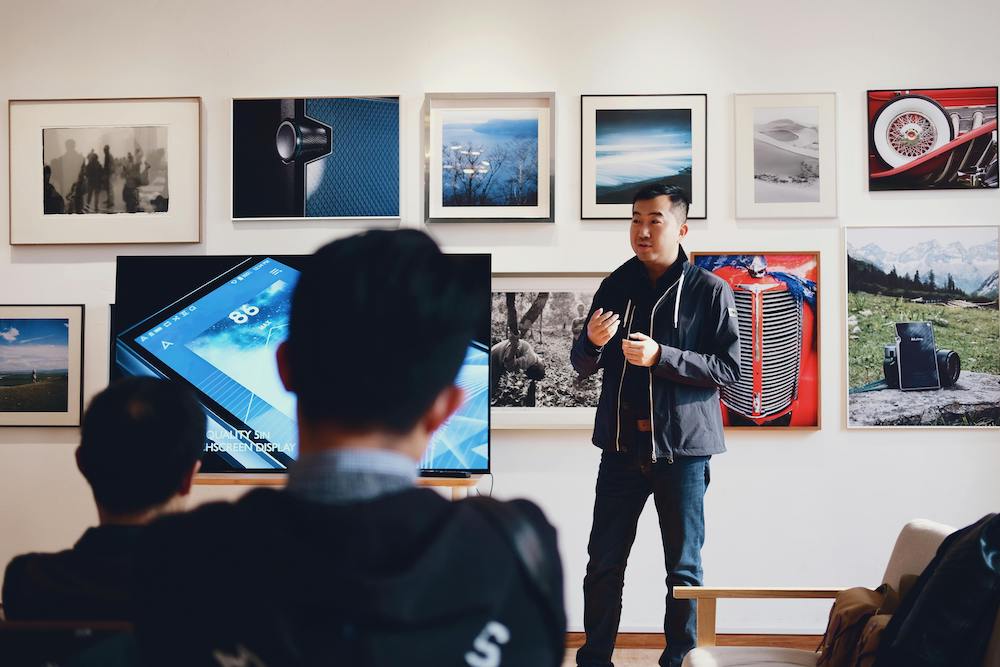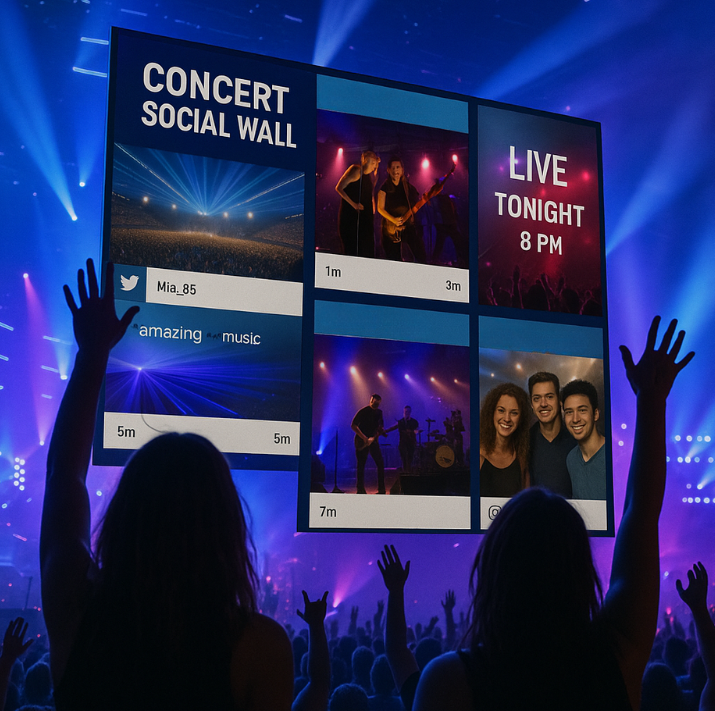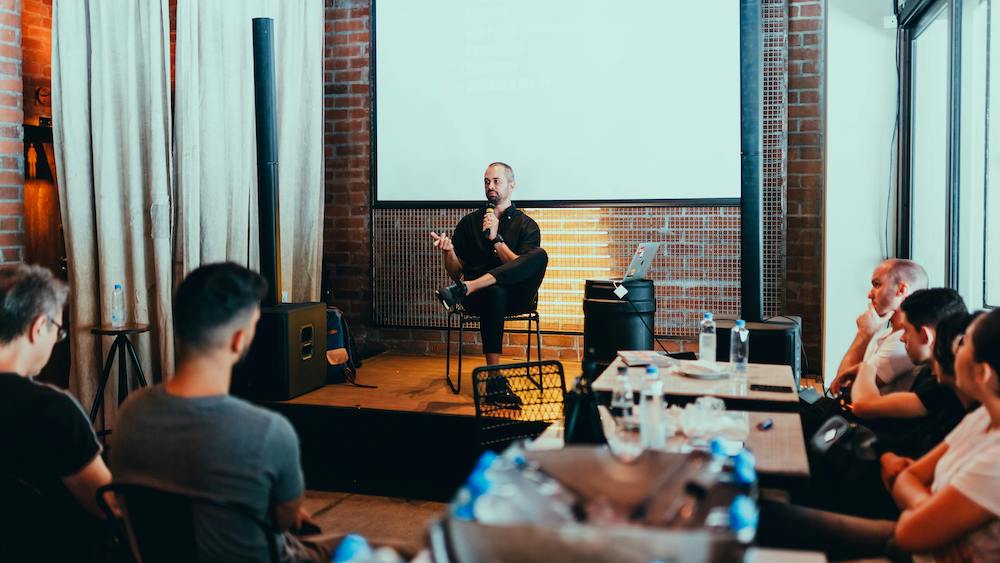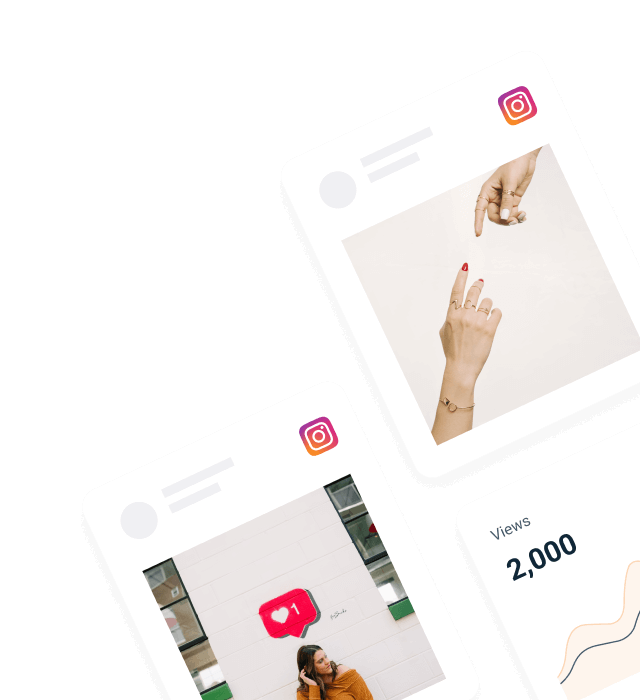Event displays need to work under conditions completely different from web design: longer viewing distances, challenging lighting, and audiences who scan quickly while moving through spaces. Here’s a quick cheat sheet to make sure you get it right for your next event.
Key Considerations For Social Wall Design
- Font sizes: Minimum 48pt headlines, 36pt body text, 42pt hashtags for readability at 10-20 foot viewing distances
- High contrast: Use white/light text on dark backgrounds or black text on bright backgrounds to handle venue lighting
- Grid layouts: Display 6-9 social media posts with clear spacing—avoid cramped or overlapping designs
- Rotation timing: 5-10 seconds for high-energy events, 15-30 seconds for professional settings
- Hashtag prominence: Keep event hashtags constantly visible in high-contrast colors
- Screen sizing: 55″ minimum for conference rooms, 65″+ for large venues
- Content moderation: Pre-approve official sources, assign dedicated staff for live moderation
- Strategic placement: Eye level in gathering spaces beats dramatic mounting in high-traffic areas
Here are the design principles that create effective social walls for live events, plus practical guidance for implementation across different event types.
Typography and Readability for Large Displays + Consistent Branding
Text that looks perfect on your laptop becomes unreadable on event screens viewed from across the room. Here’s how to size and choose typography that works at viewing distances of 10-20 feet.
Font sizing for distance viewing
Event screens are typically viewed from 10-20 feet away, requiring significantly larger text than web or print design.
Recommended minimums:
- Headlines: 48pt for conference rooms, 72pt+ for large venues
- Body text: 36pt minimum, 48pt+ for high-traffic areas
- Hashtags and calls-to-action: 42pt minimum
Test your typography by printing samples at actual size and viewing from expected distances. This reveals readability issues that aren’t apparent on computer screens.
Font selection for screen display
Sans serif fonts (Arial, Helvetica, Roboto) perform better on large displays than serif fonts. Avoid decorative, thin, or condensed typefaces that lose clarity at size.
Use bold or semi-bold weight as your default rather than regular weight, which can appear thin on large screens under venue lighting.

Color and Contrast for Venue Conditions That Match Your Brand Identity
Venue lighting conditions can completely wash out color schemes that look great on computer screens. Successful event displays use high-contrast combinations that remain readable under challenging lighting.
High-contrast combinations for reliability
Venue lighting varies dramatically—from harsh conference room fluorescents to warm ballroom ambiance to changing natural light for outdoor events.
Reliable contrast combinations:
- White or light yellow text on dark blue or black backgrounds
- Black or dark navy text on white or bright yellow backgrounds
- Any combination that passes WCAG AA accessibility standards (4.5:1 contrast ratio minimum)
Accounting for ambient lighting
Overhead fluorescent lighting washes out subtle colors and low-contrast combinations. Stage lighting can shift color perception. Natural light changes throughout the day.
When in doubt about venue lighting conditions, choose maximum contrast. Clear readability trumps aesthetic subtlety in event environments.
Layout Design for Quick Scanning That Suits Social Media Aesthetics
Event attendees glance at displays for 2-3 seconds while moving through spaces. Your layout and elements in it need to communicate information hierarchy instantly and make content attractive and easy to process at a glance.
Grid-based layouts for clarity
Clean grid arrangements with equal-sized content areas make scanning efficient. Show 6-9 posts simultaneously with clear visual separation between items.
Featured content areas can highlight trending posts or sponsor content, but keep them visually distinct from the main grid through different sizing or placement.
Strategic use of white space
Adequate spacing between content blocks improves readability and reduces visual overwhelm. Each post needs breathing room to be processed quickly.
Prominent hashtag display
Event hashtags should be constantly visible in high-contrast colors, positioned in headers or dedicated areas that don’t compete with content for attention.
Content Management and Rotation
How you handle content updates and moderation affects both audience engagement and the real-time feel that encourages participation. Here’s how to balance fresh content with quality control, especially if you are working with different platforms.
Update timing based on event pace
Content rotation speed should match the energy and attention patterns of your event:
- High-energy events (concerts, festivals): 5-10 seconds per post
- Professional conferences: 15-20 seconds per post
- Networking events: 30 seconds per post
During presentations or speeches, disable rotation to avoid distracting movement in the audience’s peripheral vision.

Content moderation workflows
Set up automated approval for verified sources (speakers, sponsors, official accounts) and keyword-filtered posts using official hashtags.
Assign dedicated staff for manual moderation during events rather than adding this responsibility to existing roles. Quick approval maintains the real-time feel that encourages participation.
Filter for visual content quality alongside appropriateness—blurry photos, illegible text, and off-topic posts should be excluded to maintain display standards.
Screen Placement and Technical Considerations
Where you position displays and what technical specifications you choose directly affects engagement. Here’s how to make strategic decisions about placement and hardware that support your social wall goals.
Strategic positioning for engagement goals
High-traffic lobby areas provide maximum visibility but brief viewing time—good for brand awareness and hashtag promotion.
Networking areas and break spaces allow longer viewing time and discussion—better for detailed content and community building.
Mount screens at eye level in areas where people naturally gather rather than in dramatic positions that look good in photos but aren’t practical for viewing.
Display specifications
55-inch minimum for conference rooms with viewing distances under 15 feet. 65+ inches for larger spaces or longer viewing distances.
Ultra-wide displays provide more content space but require custom layouts designed for their aspect ratios.
Event Type Considerations
Different event types create different audience expectations and environmental constraints. Design approaches that work for corporate conferences don’t necessarily work for entertainment events, and vice versa.
Corporate events
Use official consistent branding, brand colors and conservative typography. Include structured content like speaker quotes and session highlights alongside attendee posts. Apply stricter content moderation to maintain professional context and your brand identity.

Conferences and trade shows
Mix educational content (key takeaways, insights) with networking content (attendee introductions, meetups). Use hashtag organization to separate different content types. Include booth numbers and product information to connect online engagement with physical booth visits.
Entertainment events
Bold colors and faster rotation work well. Focus on crowd energy, performer highlights, and fan reactions. Professional polish matters less than capturing event excitement.
Using Juicer for Technical Implementation
Multi-platform content aggregation involves API management, authentication, and format normalization—technical complexity that can overshadow design decisions. Here’s how Juicer handles the backend so you can focus on creating effective interactive displays.
Design templates optimized for events
Pre-built templates include appropriate font sizing, high-contrast color schemes, and layouts designed for quick scanning in event environments. Customization options allow brand integration without starting from scratch.
Real-time moderation tools
Mobile-friendly approval interfaces let staff moderate content during events without complex dashboard navigation. Automated filtering handles obvious spam while maintaining authentic content variety.
Reliable content delivery
Content updates appear within minutes of posting. Cached content prevents display gaps during brief internet interruptions. Responsive layouts adapt to different screen sizes and orientations automatically.

Pre-Event Setup Process
Successful social wall implementation requires systematic preparation across design, technical, and operational areas. Here’s how to organize your setup timeline to avoid last-minute issues.
Design phase
- Test typography and color choices on actual display screens under venue lighting conditions
- Create moderation rules and approval workflows
- Design backup static content for internet interruptions
- Train staff on content management procedures
Technical setup
- Confirm screen specifications and mounting locations
- Test internet connectivity and backup options
- Set up content sources and hashtag tracking
- Create clear hashtag promotion materials
Event day preparation
- Test all displays before attendees arrive
- Verify staff access to moderation tools
- Monitor initial hashtag adoption and adjust promotion as needed
- Have technical support contacts readily available
Performance Measurement
Tracking the right metrics helps you understand whether your social wall design is supporting your event goals and where you can improve for future events.
Participation metrics
Track hashtag usage rates compared to baseline social media activity around your events. Monitor content variety to ensure broad participation rather than just a few active contributors.
Engagement assessment
Observe dwell time near displays and whether attendees are stopping to read content or walking past. Note which content types generate the most audience interaction.
Goal alignment
Evaluate social wall performance based on broader event objectives—networking facilitation, brand awareness, community building, or information sharing—rather than just social media metrics.
Connect social wall engagement data to other event success indicators like attendee satisfaction, networking quality, or post-event survey responses.
Practical Design for Real Event Conditions
Social wall design requires balancing visual appeal with practical constraints of live event environments. Venues present challenges different from web or print design, and audiences interact with displays differently than other media.
Focus on readability, clear information hierarchy, and reliable technical performance. These fundamentals create effective social walls that enhance event experiences and leave a lasting impression rather than just displaying content.
Ready to create social walls optimized for event environments? Try Juicer free for 14 days and focus on design choices that work in real venues.
Frequently Asked Questions
What screen specifications work best for different venue sizes?
Conference rooms (up to 100 people): 55-65 inch displays work well for viewing distances under 15 feet. Large venues (200+ people): 75+ inch displays or video wall configurations for viewing distances over 20 feet. Consider ultra-wide displays for more content space, but design custom layouts for their aspect ratios.
How do you choose appropriate content rotation timing?
Match rotation speed to event energy and audience attention patterns. Fast-paced events can handle 5-10 second rotation. Professional settings with detailed content need 15-30 seconds per post. Disable rotation during presentations to avoid distracting movement.
How do you design for multiple screen sizes and orientations?
Don’t just focus on social media aesthetic trends. Design for your primary large display first, then adapt for secondary screens. Ensure mobile versions are readable but don’t compromise large screen effectiveness. If you add interactive elements, keep the different angles and distances of viewers in mind. Most attendees view social walls on event displays rather than personal devices.
What backup plans work for technical issues?
Prepare static content featuring sponsor messages, event information, or highlights from previous events. Use tools that cache content locally to handle brief internet interruptions. For critical events, consider dedicated internet connections rather than relying on venue WiFi.
How do you integrate sponsor content without overwhelming attendee posts?
Use a 70/30 split favoring attendee content with strategic sponsor messages. Make sponsored content visually distinct through different styling or dedicated placement areas. Ensure sponsor messages add value rather than just promotional messaging.
How do you encourage hashtag adoption?
Display specific hashtags prominently on the social wall and throughout event materials—signage, speaker slides, name badges. Announce hashtags verbally during sessions and breaks. Show examples of good posts that demonstrate proper hashtag usage. Make participation instructions clear and memorable.




